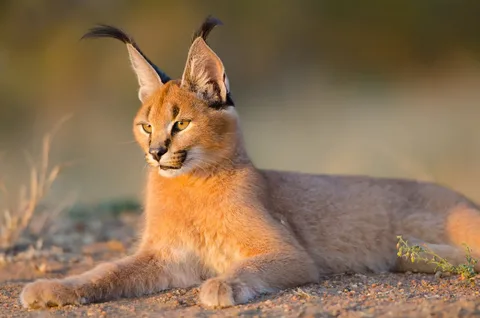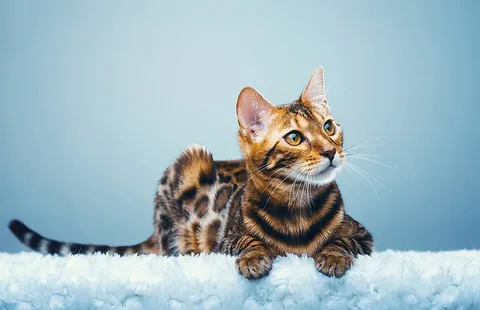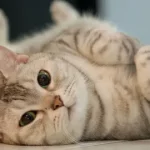You might think you’ve seen enough wonders these days, but, on planet Earth, there is always something surprising. In this article, we will talk about rare cat species in the world, which you may not have seen or heard of before, so follow us.
The number of cat breeds recognized globally is either 44 by the Cat Fanciers Association, 49 by the International Federation of National Cat Societies, or 73 by the International Cat Association. Of course, there are rare breeds that are less common than others, either because of their small number of births, because they were recently discovered in certain places, or because of their strange shape. Whatever the reason, they remain exceptionally exotic breeds that will undoubtedly amaze onlookers. So, we will take a look at some of the rarest cat species in the world
1. Serengeti

The Serengeti cats were first developed by crossing a Bengal and an Oriental Shorthair. Serengeti’s are spotted cats, with long legs and large, round-tipped ears. They have a long neck that blends with the base of the skull without tapering.
Even though those cats are bred from different species they are relatively healthy animals. They are susceptible to common feline diseases but rather than that those cats can have a life expectancy of up to 10 years.
2. Sphynx

This hairless breed of cat was created through selective breeding back in the 1960s. Did you know that even though these cats appear to be “hairless” they aren’t? Instead, their skin is covered in fine hairs that are said to resemble the feeling of chamois leather. Because of this, they lose more body heat than their hair-covered counterparts.
The Sphynx has been described as being more dog-like than an actual cat because of their very friendly attitude towards strangers and they greet their owners at the door. They can live to be around 13 to 14 years old and require a bath every 1 to 2 weeks because the oils on their body build up.
3. Turkish Angora

Originating from Turkey, the Turkish Angora has been recorded as being around since the early 17th century. It’s believed that these cats are the origin of the mutation of long hair and the white color pattern in cats.
Owners of a Turkish Angora know just how much these cats love attention and it’s recommended that these cats be left alone for no more than 4 to 8 hours a day. That being said, these cats act well around people and their life expectancy is anywhere from around 15 to 18 years. These social and intelligent creatures are also known for having heterochromia, a mutation that gives them two different eye colors.
4. Kurilian Bobtail

This fluffy little breed originates from the cold tundra of Russia and depending on the specific cat can either have a short coat or a long coat that is constantly shedding, so grooming them is considered to be high maintenance. Just like the Egyptian Mau, the Kurilian Bobtail is considered to be extremely vocal and is often heard meowing, especially throughout the night.
These cats make for especially good pets as they are moderately affectionate with people but still like to have some quality time for themselves. Kurilian Bobtails are a relatively healthy breed but owners should watch out for diarrhea and Feline Lower Urinary Tract Disease. Other than that, these cats should be expected to live around 14 to 20 years.
5. Tonkinese Cat

These adorable little cats are a true crossbreed between a Burmese and a Siamese cat. Their coats are known to come in four different color variations; natural, champagne, blue, and platinum. They can also be distinguished by their signature aquamarine-colored eyes.
The Tonkinese is now officially recognized as a natural breed as it was discovered that they’ve been around since the 14th century. This breed is especially playful and lively thanks to their parents and should only be considered by those who want an interactive feline friend.
6. Caracal

This wild cat is known for being quite secretive which makes it rather difficult to observe and can be found living in the regions of Persia, Africa, the Middle East, etc. What makes it even more difficult to study is that these cats are mostly nocturnal and typically live alone or sometimes in pairs.
Caracals live off of a diet of small rodents, birds, and mammals but unfortunately, their habit is being threatened by agricultural expansion and desertification, which is why they’re classified as Least Concern. Female caracals are capable of reproducing a litter of around 1-6 kittens that usually go off on their own for around 9 to 10 months, however, some females will stay behind for a little longer.
7. Egyptian Mau

This short-haired breed of cat is recognized for its famous spots which make it one of the very few breeds of domesticated cats that have naturally occurring spots. Fun fact: Egyptian Maus are the fastest breed of domesticated cats and have been recorded at running up to speeds of up to 30 miles per hour! Not only that but they’re known for having quite the musical voice and friendly personality.
To give you an idea of how rare this breed is, it was noted in 2006 that there was only a total of 6,742 Maus that were registered with the Cat Fancier’s Association.
8. British Shorthair

Known as one of the most ancient breeds to exist, the British Shorthair remains the most famous pedigreed breed in all of Great Britain. This was the cat that inspired another famous cat in literature, Alice in Wonderland’s very own Cheshire Cat and the “I Can Have Cheezburger?” meme.
British shorthairs usually are seen sporting a blueish gray coat, but other variations such as tabby, and colorpoint are known to occur, and with the well-known copper eyes.
9. Norwegian Forest cat

The Norwegian Forest cat – is a breed of domestic cat originating in Northern Europe. This breed is adapted to a cold climate, with a top coat of glossy, long, water-shedding hairs and a woolly undercoat for insulation. Currently, the Norwegian Forest breed is very popular in Norway, Sweden, Iceland, and France.
It is a big, strong cat, similar to the Maine Coon breed, with long legs, a bushy tail, and a sturdy body. The breed is very good at climbing since they have strong claws. The lifespan is usually 14 to 16 years, though kidney and heart diseases have been reported in the breed.
10. Minskin

Minskin cat is named for its miniature size and soft-as-cashmere sparsely coated skin, highlighted by short, soft fur “points” on the extremities: face, ears, legs, and tail. The Minskins are only a decade old. They began to be developed in Boston in 1998 by breeder Paul McSorley, who achieved the look and personality he wanted by crossing the Sphynx and the Munchkin.
Those cats are generally healthy. The Minskin’s minimal coat is nonshedding and easy to groom. Like with sphynxes regular bathing with a mild shampoo is necessary to keep the skin supple and healthy.



